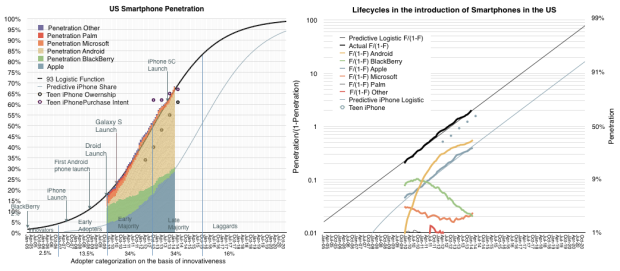Philip Elmer-DeWitt cited Piper Jaffray’s latest Teen Survey on Device Ownership where ~7,500 teens in the US are asked about their device ownership. This type of data is similar to the method comScore uses to measure penetration smartphones in the US making the two data sets comparable.
The combined data is shown the following graphs.
One graph is the penetration data and the other is the ratio of penetration to unpenetrated on a log scale. The PJC Teen Survey data is shown as dots on both graphs. In the spring of 2012 the difference between teen iPhone ownership and overall population iPhone ownership was 20 percentage points. In the fall 2012 it was 22 points. In spring 2013 it was 25 points. The spread increased to 30 points in the fall of 2013.
This implies that the latest sample (April 2014) should have at least a 31 point lead on what comScore will report in another two months.1 In other words current iPhone penetration in the US is probably 30%. This assumes of course that the relationship between teens and overall population has not changed. But there is consistency in the pattern of iPhone growth for over 50 months.
In addition, the purchase intent data is showing that there is growing interest and that interest reflects demand which has been largely met by a purchase decision.
Teens are leading adoption in this particular sector because the device is very well suited to the jobs that they need to do, mainly social interaction. It’s no coincidence that the audiences for the fastest-rising services (SnapChat, WhatsApp, Vine, YouTube, Instagram) consist mainly of teens. They also lead adoption in FaceBook, iTunes, MySpace, etc. In that regard teens are an early indicator of mainstream behavior.
Teens taught the world new habits throughout the 20th century2 and they certainly seem to be teaching us in the present.
- comScore reports data during the first week of a month for a period ending one month earlier. So the April release covers a sampling period ending February [↩]
- An entertaining review of the contribution (and invention) of teenagers in the 20th century can be enjoyed in James May’s 20th Century Episode 5 [↩]
Discover more from Asymco
Subscribe to get the latest posts sent to your email.

